
Home » Themes » Landscape » Settlement
Amoy ShepherdsPrint Page 
The monument commemorates the Amoy Shepherds who left their famine-ravaged villages in Amoy, now known as Xiamen in China and who came under five-year contracts in the mid-1800s to St George. About 300 came as indentured labourers, working as shepherds and labourers tending to more than 450,000 sheep.
Most never made the journey home to their village, unable to pay their way on their minimal wages. Burial records of the Amoy shepherds were destroyed by flood and timber headstones destroyed by fire.
The monument has artwork designed by local student Daisy Brown, showing how her ancestors, the Kamilaroi people, allowed the Chinese labourers to enter their land along the Balonne River. Alongside the drawing, a 1300-year-old Tang dynasty poem is inscribed.
Location
| Address: | 12069 Carnarvon Highway, St George Cemetery, St George, 4487 |
|---|---|
| State: | QLD |
| Area: | AUS |
| GPS Coordinates: | Lat: -28.022967 Long: 148.603868 Note: GPS Coordinates are approximate. |
Details
| Monument Type: | Monument |
|---|---|
| Monument Theme: | Landscape |
| Sub-Theme: | Settlement |
| Approx. Event Start Date: | 1848 |
| Artist: | Daisy Brown |
| Monument Manufacturer: | Kwong Wha TSE, Director of Wing Hing Builders (QLD) |
Dedication
| Actual Monument Dedication Date: | Saturday 30th March, 2019 |
|---|
In memoriam
To the young men who, around 1850, left the famine in Amoy to become indentured shepherds and those who, in the 1880s, drifted here in itinerant "coolie" gangs after the Palmer River gold had gone
These sojourners never earned enough to return to the families left behind in their ancestral villages.
Here now they lie silent witness to the settlement history of this region.
Leaving home and hearth
They first came in 1848, as indentured shepherds, 300 from Amoy to mind 450,000 sheep, spread across the Darling Downs. Their first winter would have been a shock: frost on the ground and very rough huts.
It was not a successful venture. Most, if not all, never saw their families again. They endured a lonely and impecunious life to the end.
We honour
We erect this memorial to honour their noble attempt to cross the seas to fight the famine in their clan villages.
Sojourners no more
If they could hear us, we would like to tell them that we now enjoy the freedom and bounty of this land. And we are able to put aside stores for unforeseen circumstances. There are a million Chinese Australians now.
We are academics, artisans, menial workers, people in the arts, business owners in every niche, public servants, scientists and doctors, and even the occasional cult hero like Mao`s Last Dancer.
The last frontier
However, so few of us yet are in Parliament. We have wondered and wondered as to why this is so. Is Australia yet fully ready to embrace us as bona fide citizens ?
Rest in peace, all ye who nobly crossed the southern oceans before us. For the sake of those who come after us, we will honour our committment to cross the last frontier, in what is now a multicultural society in which a hundred flowers bloom, most of the time.
Bless our journey
[Inscription in Mandarin]
Heartbeats in the deep of night
The moonlight shines bright beyond my bed
I wonder if there`s frost on the ground outside
I raise my head to see the moon
I lay down my head and yearn for my ancestral village.
This poem by Li Bai, (701 - 762), a Tang Dynasty poet, aptly evokes the loneliness that the Amoy shepherds would have felt in the desolate sheep runs of the Darling Downs in mid 19th century.
An Aboriginal picture
It is the winning entry in a design competition for school children, from 11-year -old Daisy Brown, a descendant of the Kamileroi people who once roamed along the Balonne River, which formed the western boundary of Kamileroi country, covering some 29,000 square miles, 32 times the size of the ACT and one third the size of Victoria.
Bridge over the river
At the prize-giving dinner on 21 April 2018, Daisy explained that the idea behind the design was to show that her people allowed the Chinese to enter their land. The St George Chinese Community Memorial Committee was delighted with the imagery of this picture.
A multicultural flowering
To see a young girl of aboriginal descent imagining how her ancestors, 160 years ago, might have accomodated and perhaps welcolmed the first Chinese who came to Queensland, gives all of us hope.
Hope that she and her peers, some of whom may have descended from the Amoy shepherds, would once more roam along the banks of the Balonne River, in spirit at least, and welcome visitors who come from abroad in search of a better life.
Hope that we, "the children of the dragon", will always feel welcome in this new land, the homeland of our children and our children`s children.


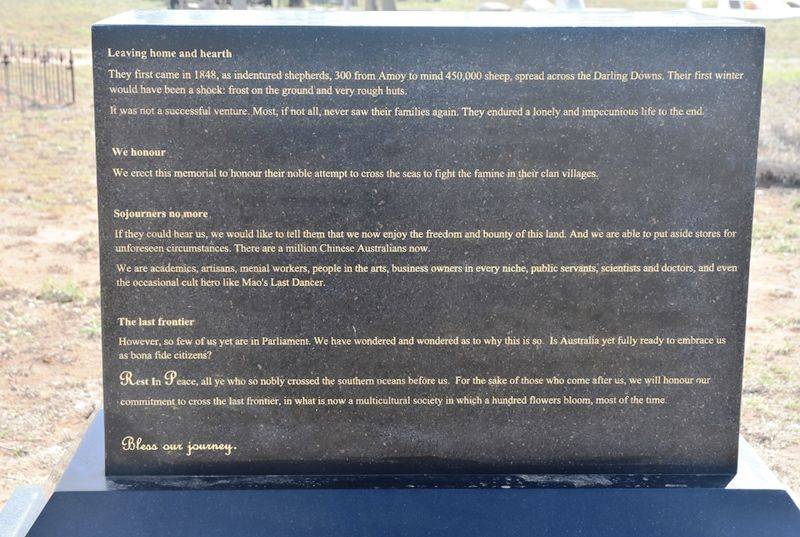
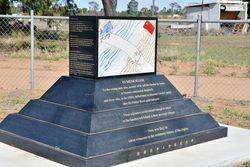
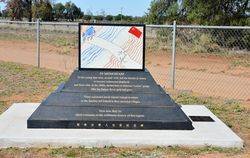
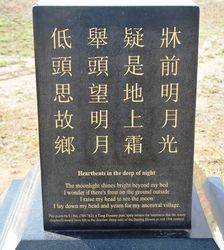

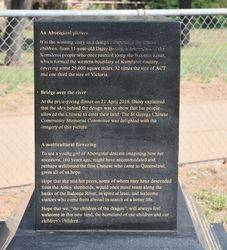
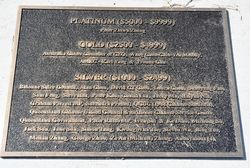
 Memorial Unveiling 2019
Memorial Unveiling 2019
